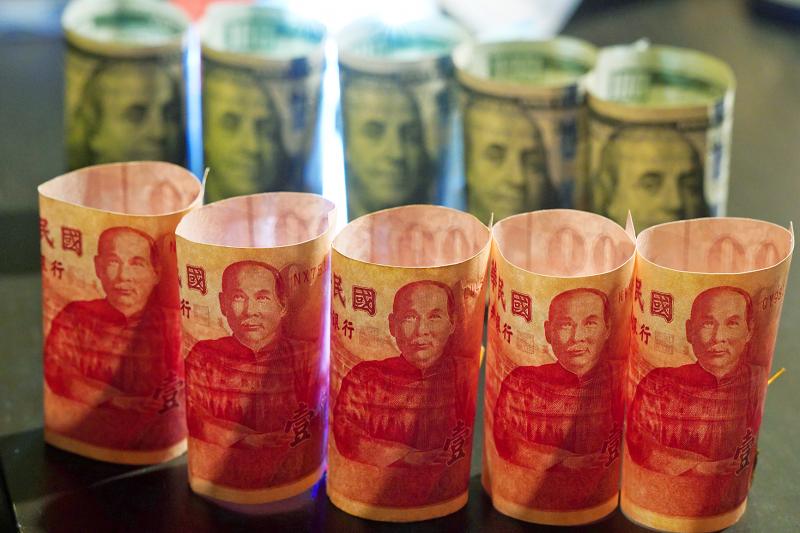The New Taiwan dollar yesterday plunged to its lowest against the US dollar in almost two years, on the back of fears the US Federal Reserve could take a more hawkish approach to tightening in the wake of the latest US consumer price index (CPI) report, dealers said.
The NT dollar fell by NT$0.118 to close at NT$29.823 against the US dollar, the lowest level since June 5, 2020, when the local currency closed at NT$29.839 against the greenback.
Dealers said that soon after the local foreign exchange market opened, the US currency attracted strong buying, as investors took their cue from the US CPI report, with the index rising 8.3 percent last month, faster than a consensus estimate of 8.1 percent, although the figure was lower than March’s 8.5 percent increase.

Photo: CNA
CPI growth last month was still the highest in almost 40 years, leaving investors expecting the Fed to speed up the speed of its rate hike cycle launched in March, which has caused an exodus of foreign funds from Taiwan.
The Fed raised its key interest rates by 25 basis points in the middle of March and another 50 basis points early this month.
Dealers said the heavy losses on the local equity market, with net sales of NT$10.32 billion (US$346 million) of shares on the main board, increased the downward pressure on the NT dollar.
The TAIEX ended down almost 400 points, or 2.43 percent, at the day’s low of 15,616.68 points.
The fall was led by the bellwether electronics sector, as investors expect rising interest rates to make tech stocks at home and abroad less attractive, dealers said.
Before the local foreign exchange market closed, central bank Governor Yang Chin-long (楊金龍) told a meeting of the legislature’s Finance Committee that he would not rule out the bank intervening in the market to prevent further NT dollar volatility and to stabilize the foreign exchange market.
The central bank took to the trading floor in March and last month, selling US dollars to shore up the NT dollar, a move which saw the country’s foreign exchange reserves fall two months in a row.
Despite the flight of some foreign funds, Taiwan remains awash in liquidity, which should help the local economy steam ahead, Yang said.

Among the rows of vibrators, rubber torsos and leather harnesses at a Chinese sex toys exhibition in Shanghai this weekend, the beginnings of an artificial intelligence (AI)-driven shift in the industry quietly pulsed. China manufactures about 70 percent of the world’s sex toys, most of it the “hardware” on display at the fair — whether that be technicolor tentacled dildos or hyper-realistic personalized silicone dolls. Yet smart toys have been rising in popularity for some time. Many major European and US brands already offer tech-enhanced products that can enable long-distance love, monitor well-being and even bring people one step closer to

Malaysia’s leader yesterday announced plans to build a massive semiconductor design park, aiming to boost the Southeast Asian nation’s role in the global chip industry. A prominent player in the semiconductor industry for decades, Malaysia accounts for an estimated 13 percent of global back-end manufacturing, according to German tech giant Bosch. Now it wants to go beyond production and emerge as a chip design powerhouse too, Malaysian Prime Minister Anwar Ibrahim said. “I am pleased to announce the largest IC (integrated circuit) Design Park in Southeast Asia, that will house world-class anchor tenants and collaborate with global companies such as Arm [Holdings PLC],”

TRANSFORMATION: Taiwan is now home to the largest Google hardware research and development center outside of the US, thanks to the nation’s economic policies President Tsai Ing-wen (蔡英文) yesterday attended an event marking the opening of Google’s second hardware research and development (R&D) office in Taiwan, which was held at New Taipei City’s Banciao District (板橋). This signals Taiwan’s transformation into the world’s largest Google hardware research and development center outside of the US, validating the nation’s economic policy in the past eight years, she said. The “five plus two” innovative industries policy, “six core strategic industries” initiative and infrastructure projects have grown the national industry and established resilient supply chains that withstood the COVID-19 pandemic, Tsai said. Taiwan has improved investment conditions of the domestic economy

Sales in the retail, and food and beverage sectors last month continued to rise, increasing 0.7 percent and 13.6 percent respectively from a year earlier, setting record highs for the month of March, the Ministry of Economic Affairs said yesterday. Sales in the wholesale sector also grew last month by 4.6 annually, mainly due to the business opportunities for emerging applications related to artificial intelligence (AI) and high-performance computing technologies, the ministry said in a report. The ministry forecast that retail, and food and beverage sales this month would retain their growth momentum as the former would benefit from Tomb Sweeping Day